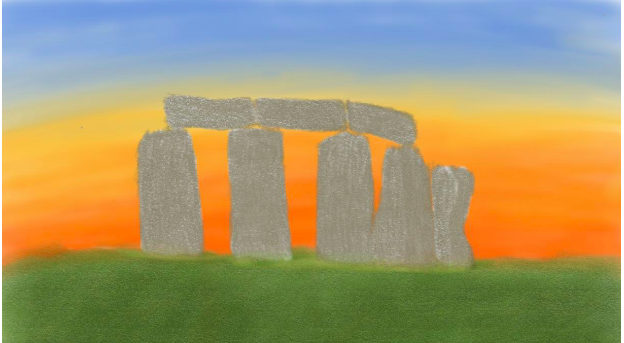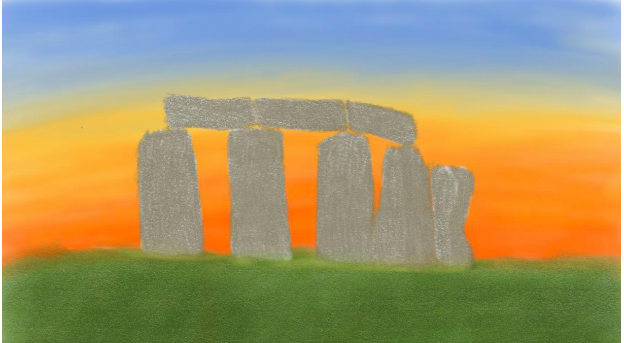The Stonehenge

The Stonehenge, constructed over generations and made of stones carried over tens of hundreds of kilometres on boats made of carven logs. The intentions behind the Stonehenge are likely around marking the life-changing seasons and creating rituals around them.
The stones, imagine them being hammered out with antler-picks and carried through the storm and rough rivers, them arriving. The men could haul them off the carven log-boats to a wooden sleigh they prepared earlier. They might drag them out to their respective places, the only things possibly aiding them were their own strength in numbers and the thick stick they used as a lever. These stones, known in future times as bluestones, were, and still are roughly 5300 years ago today, a part of the mysterious Stonehenge.
Why would they go through the effort to construct such a structure, especially in their wheel-less age? The larger stones in the Stonehenge (called Sarsen stones, if you were curious) were dragged about 20 kilometres by no means other than makeshift sleigh, to then drag them into ditches, and painstakingly pull them upright. Why would they go through so much labour for it? Well…
A village priest might lookout, the generations of the past commissioned that project that he looked upon. It was a solar calendar, used to mark which season came when, and while that sounded mundane, to the people who made it, the seasons were vital.
The winter seasons brought harsh colds and food shortages, whereas the brighter summer months were times of relative prosperity. They used what we know as the Stonehenge to mark important events, like the summer and winter solstices. To them, these events marked the start of winter and the hope of a new prosperous year. Essentially the Stonehenge was the centre for rituals and ceremonies around said important events because for people back then, everything was about food and its supply. Now to our pondering priest.
He could appreciate the labour of the many men who worked on it, on those who used antlers to carve what amounts to woodworking grooves in the massive stones, on those who had the will to drag and boat stones across perhaps hundreds of miles. He had talked to some of the craftsmen earlier, apparently, the summer storms were interrupting their work in the final stages of the structure, but that it was coming along well enough.
Despite how casually one may write about the construction of the Stonehenge, it must be restated how much of an engineering marvel it is. Once more, they built it in an age without the wheel, dragging sometimes 20-ton stones on wooden sleighs, shipping 4 ton stones with boats that were literally hollowed-out tree trunks, the feat they accomplished with the Stonehenge is not one we can skim over, because we cannot see Stonehenge’s every 50 kilometres, can we?
The Stonehenge. They went through all kinds of labour to build it because it represented the cycle between warm prosperity and cold famine, between times where life thrives, and times where we could die. It also represents what humanity can do if it puts its mind to it. Really, it represents 2 sides of humanity's multi-sided coin, the will to find resources, and the will to do something, even if it's hard. Humanity needs resources, like food, to survive, but unlike many other creatures, we are willing to go to extreme lengths to live comfortably and to pursue what we think is right. Ultimately, Stonehenge represents why humanity is what it is, unique.

References
https://www.youtube.com/watch?v=yP2DlTwQuIY
https://www.youtube.com/watch?v=Fx-KrvuiafE
Author biography
Mikail Imthiyaz, a 13 year old, likes literature and science, has been a member of the prestigious Leaders of Tomorrow programme by Professor Ugail in 2021. He enjoys sharpening his writing skills and attempting his level best at drawing.

Cite this article as:
Mikail Imthiyaz, The Stonehenge, theCircle Composition, Volume 1, (2021). https://thecirclecomposition.org/the-stonehenge/
